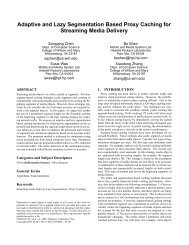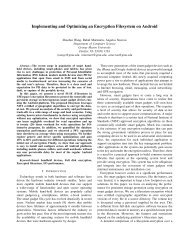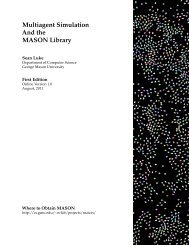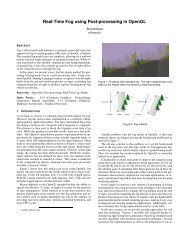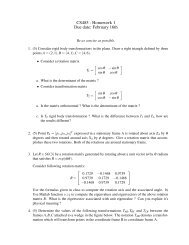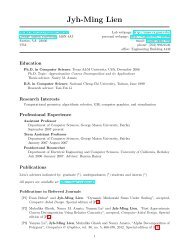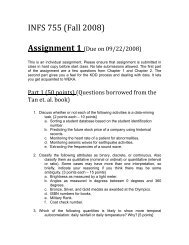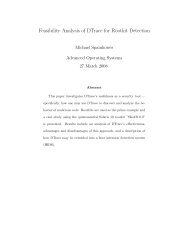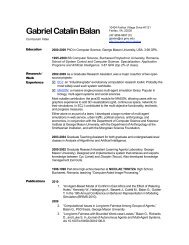Compute certainty map from correlations input depth map certainty ...
Compute certainty map from correlations input depth map certainty ...
Compute certainty map from correlations input depth map certainty ...
Create successful ePaper yourself
Turn your PDF publications into a flip-book with our unique Google optimized e-Paper software.
<strong>Compute</strong> <strong>certainty</strong> <strong>map</strong> <strong>from</strong> <strong>correlations</strong><br />
<strong>input</strong> <strong>depth</strong> <strong>map</strong> <strong>certainty</strong> <strong>map</strong><br />
1
scanline<br />
Left Right<br />
SSD
scanline<br />
Left Right<br />
Norm. corr
• If necessary, rectify the two stereo images to transform epipolar lines<br />
into scanlines<br />
• For each pixel x in the first image<br />
Find corresponding epipolar scanline in the right image<br />
Examine all pixels on the scanline and pick the best match x’<br />
<strong>Compute</strong> disparity x-x’ and set <strong>depth</strong>(x) = B*f/(x-x’)
Textureless surfaces<br />
Non-Lambertian surfaces, specularities<br />
Occlusions, repetition
• The similarity constraint is local (each reference<br />
window is matched independently)<br />
• Need to enforce non-local correspondence<br />
constraints
• Uniqueness<br />
For any point in one image, there should be at<br />
most one matching point in the other image
Usually, order of points in two images is<br />
same.<br />
Is this always true?<br />
If we match pixel i in image 1 to pixel j in<br />
image 2, no matches that follow will affect<br />
which are the best preceding matches.<br />
Example with pixels (a la Cox et al.).<br />
8
• Uniqueness<br />
For any point in one image, there should be at most<br />
one matching point in the other image<br />
• Ordering<br />
Corresponding points should be in the same order in<br />
both views<br />
Ordering constraint doesn’t hold
Smoothness: disparity usually doesn’t change too<br />
quickly.<br />
Unfortunately, this makes the problem 2D again.<br />
Solved with a host of graph algorithms, Markov Random<br />
Fields, Belief Propagation, ….<br />
Uniqueness constraint (each feature can at most<br />
have one match)<br />
Occlusion and disparity are connected.<br />
10
• Try to coherently match pixels on the entire scanline<br />
• Different scanlines are still optimized independently<br />
Left image Right image
q<br />
t<br />
s<br />
p<br />
Can be implemented with dynamic programming<br />
Ohta & Kanade ’85, Cox et al. ‘96<br />
Left<br />
occlusion<br />
Right<br />
occlusion<br />
Left image<br />
Right image<br />
Slide credit: Y. Boykov
Find the minimum-cost path going monotonically<br />
down and right <strong>from</strong> the top-left corner of the<br />
graph to its bottom-right corner.<br />
• Nodes = matched feature points (e.g., edge points).<br />
• Arcs = matched intervals along the epipolar lines.<br />
• Arc cost = discrepancy between intervals.<br />
13
Find the minimum-cost path going monotonically<br />
down and right <strong>from</strong> the top-left corner of the<br />
graph to its bottom-right corner.<br />
• Nodes = matched feature points (e.g., edge points).<br />
• Arcs = matched intervals along the epipolar lines.<br />
• Arc cost = discrepancy between intervals.<br />
CS 223b<br />
14
• Scanline stereo generates streaking artifacts<br />
• Can’t use dynamic programming to find spatially<br />
coherent disparities/ correspondences on a 2D grid
Regions without texture<br />
Highly Specular surfaces<br />
Translucent objects<br />
17
What if the scanlines are not aligned ?<br />
Given general displacement how to warp the views<br />
Such that epipolar lines are parallel to each other<br />
How to warp it back to canonical configuration<br />
(more details later)<br />
(Seitz)
• Rectified Image Pair<br />
• Corresponding epipolar lines are aligned with the scan-lines<br />
• Search for dense correspondence is a 1D search<br />
19
Basic Equations<br />
Epipolar Geometry<br />
Image Rectification<br />
Reconstruction<br />
Correspondence<br />
Active Range Imaging Technology<br />
Dense and Layered Stereo<br />
Smoothing With Markov Random Fields<br />
21
Space-time stereo scanner<br />
uses unstructured light to aid<br />
in correspondence<br />
Result: Dense 3D mesh (noisy)<br />
22
ectified<br />
23
• Project “structured” light patterns onto the object<br />
Simplifies the correspondence problem<br />
Allows us to use only one camera<br />
projector<br />
camera<br />
L. Zhang, B. Curless, and S. M. Seitz.<br />
Rapid Shape Acquisition Using Color Structured Light and Multi-pass Dynamic<br />
Programming. 3DPVT 2002
L. Zhang, B. Curless, and S. M. Seitz.<br />
Rapid Shape Acquisition Using Color Structured Light and Multi-pass Dynamic<br />
Programming. 3DPVT 2002
http://bbzippo.wordpress.com/2010/11/28/kinect-in-infrared/
Many slides adapted <strong>from</strong> S. Seitz
• Generic problem formulation: given several images of<br />
the same object or scene, compute a representation of<br />
its 3D shape
The third view can be used for verification
Goal: Assign RGB values to voxels in V<br />
photo-consistent with images
Space Carving<br />
Voxel based methods<br />
Silhoute based methods<br />
31
http://www.cs.washington.edu/homes/furukawa/<br />
gallery/<br />
Yasutaka Furukawa and Jean Ponce,<br />
Accurate, Dense, and Robust Multi-View Stereopsis, CVPR 2007.
YouTube video, high-quality video<br />
Yasutaka Furukawa, Brian Curless, Steven M. Seitz and Richard Szeliski,<br />
Towards Internet-scale Multi-view Stereo,CVPR 2010.




